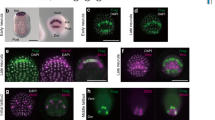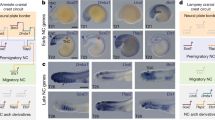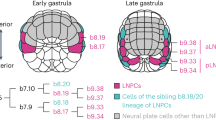Abstract
During gastrulation in vertebrates, dorsal ectoderm is induced to form neural tissue that later gives rise to the brain and spinal cord. This induction depends on signals arising from a group of cells on the dorsal side of the gastrula. This group of cells constitutes the organizer1,2. It is thought that the organizer initially induces neural tissue with anterior, or forebrain, character, and that other signals subsequently posteriorize neural tissue in the trunk2,3. Here we show that development of the anterior central nervous system of the zebrafish embryo also depends on a small group of ectodermal cells located in the prospective head region. Removal of these ectodermal cells during gastrulation perturbs subsequent neural patterning and results in widespread cell death. Transplantation of these cells shows that they can induce forebrain-specific gene expression in more posterior regions of the neural plate. Our results indicate that an early step in neural patterning is the establishment of a small population of signalling cells within the most anterior region of the embryo. These cells are required for patterning and survival of the anterior brain.
This is a preview of subscription content, access via your institution
Access options
Subscribe to this journal
Receive 51 print issues and online access
$199.00 per year
only $3.90 per issue
Buy this article
- Purchase on Springer Link
- Instant access to full article PDF
Prices may be subject to local taxes which are calculated during checkout





Similar content being viewed by others
References
Lemaire, P. & Kodjabachian, L. The vertebrate organizer: structure and molecules. Trends Genet 12, 525–531 (1996).
Sasai, Y. & DeRobertis, E. M. Ectodermal patterning in vertebrate embryos. Dev. Biol. 182, 5–20 (1997).
Woo, K. & Fraser, S. E. Specification of the zebrafish nervous system by nonaxial signals. Science 277, 254–257 (1997).
Li, Y., Allende, M. L., Finkelstein, R. & Weinberg, E. S. Expression of two zebrafish orthodenticle-related genes in the embryonic brain. Mech. Dev. 48, 229–244 (1994).
Neave, B., Rodaway, A., Wilson, S. W., Patient, R. & Holder, N. Expression of zebrafish GATA3 (gta3) during gastrulation and neurulation suggests a role in the specification of cell fate. Mech. Dev. 51, 169–182 (1995).
Brand, M. et al. Mutations affecting development of the midline and general body shape during zebrafish embryogenesis. Development 123, 129–142 (1996).
Thisse, C., Thisse, B., Halpern, M. E. & Postlethwait, J. H. Goosecoid expression in neurectoderm and mesoderm is disrupted in cyclops gastrulas. Dev. Biol. 164, 420–429 (1994).
Morita, T., Nitta, H., Kiyama, Y., Mori, H. & Mishina, M. Differential expression of two zebrafish emx homeoprotein mRNAs in the developing brain. Neurosci. Lett. 198, 131–134 (1995).
Akimenko, M.-A., Ekker, M., Wegner, J., Lin, W. & Westerfield, M. Combinatorial expression of three zebrafish genes related to Distal-less: part of a homeobox gene code for the head. J. Neurosci. 14, 3475–3486 (1994).
Krauss, S., Concordet, J.-P. & Ingham, P. Afunctionally conserved homolog of the Drosophila segment polarity gene hh is expressed in tissues with polarizing activity in zebrafish embryos. Cell 75, 1431–1444 (1993).
Macdonald, R. et al. Regulatory gene expression boundaries demarcate sites of neuronal differentiation in the zebrafish forebrain. Neuron 13, 1039–1053 (1994).
Barth, K. A. & Wilson, S. W. Expression of zebrafish nk2.2 is influenced by sonic hedgehog/vertebrate hedgehog-1 and demarcates a zone of neuronal differentiation in the embryonic forebrain. Development 121, 1755–1768 (1995).
Allende, M. L. & Weinberg, E. The expression pattern of two zebrafish acheate-scute homologue (ash) genes is altered in the embryonic brain of the cyclops mutant. Dev. Biol. 166, 509–530 (1994).
Shimamura, K. & Rubenstein, J. L. R. Inductive interactions direct early regionalisation of the mouse forebrain. Development 124, 2709–2718 (1997).
Fürthauer, M., Thisse, C. & Thisse, B. Arole for FGF in the dorsoventral patterning of the zebrafish gastrula. Development 124, 4253–4264 (1997).
Thomas, P. & Beddington, R. Anterior primitive endoderm may be responsible for patterning the anterior neural plate in the mouse embryo. Curr. Biol. 6, 1487–1496 (1996).
Varlet, I., Collingnon, J. & Robertson, E. J. nodal expression in the primitive endoderm is required for specification of the anterior axis during mouse gastrulation. Development 124, 1033–1044 (1997).
Bouwmeester, T., Kim, S.-H., Sasai, Y., Lui, B. & DeRobertis, E. M. Cerberus is a head-inducing secreted factor expressed in the anterior endoderm of Spemann's organizer. Nature 382, 595–601 (1996).
Bradley, L., Wainstock, D. & Sive, H. Positive and negative signals modulate formation of the Xenopus cement gland. Development 122, 2739–2750 (1996).
Mizuno, T., Yamaha, E., Wakahara, M., Kuroiwa, A. & Takeda, H. Mesoderm induction in zebrafish. Nature 383, 131–132 (1996).
Westerfield, M. The Zebrafish Book (Univ. Oregon Press, (1996)).
Heisenberg, C. P. et al. Genes involved in forebrain development in the zebrafish, Danio rerio. Development 123, 191–203 (1996).
Acknowledgements
We thank N. Holder, C. Kimmel, K. Whitlock and Z. Varga for comments on the manuscript and our colleagues for advice throughout this study. We thank many colleagues for providing antibodies and probes. The study was supported by grants from the BBSRC and Wellcome Trust (to S.W.W.) and from the NIH, NATO and W. M. Keck Foundation to M.W. C.H. received a Fellowship from the EC and is currently supported by the BBSRC. S.W. is a Wellcome Trust Senior Research Fellow.
Author information
Authors and Affiliations
Corresponding author
Rights and permissions
About this article
Cite this article
Houart, C., Westerfield, M. & Wilson, S. A small population of anterior cells patterns the forebrain during zebrafish gastrulation. Nature 391, 788–792 (1998). https://doi.org/10.1038/35853
Received:
Accepted:
Issue Date:
DOI: https://doi.org/10.1038/35853
This article is cited by
-
Deciphering and reconstitution of positional information in the human brain development
Cell Regeneration (2021)
-
Foxg specifies sensory neurons in the anterior neural plate border of the ascidian embryo
Nature Communications (2019)
-
vox homeobox gene: a novel regulator of midbrain-hindbrain boundary development in medaka fish?
Development Genes and Evolution (2016)
-
The molecular and cellular signatures of the mouse eminentia thalami support its role as a signalling centre in the developing forebrain
Brain Structure and Function (2016)
-
Receptor Tyrosine Kinase (RTK) Signalling in the Control of Neural Stem and Progenitor Cell (NSPC) Development
Molecular Neurobiology (2014)
Comments
By submitting a comment you agree to abide by our Terms and Community Guidelines. If you find something abusive or that does not comply with our terms or guidelines please flag it as inappropriate.



